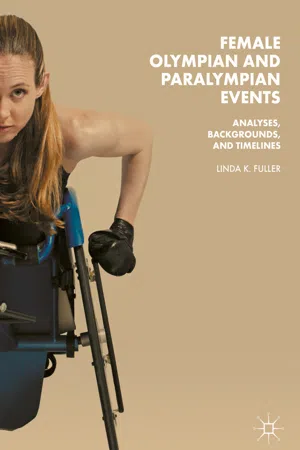Introductory Thoughts on Events for Female Olympians and Paralympians
The Games are a mega-event that de Coubertin would have a difficult time recognizing, notwithstanding his dismay at the inclusion of women in so many sports in such great numbers. As the Games move forward in the twenty-first century, if female Olympians continue to have consistent and sustained successes, opportunities should continue to grow.
—Smith and Wrynn, History of Gender and Gender Equality in the
Olympics and Paralympics (2014: 63)
Events are at the heart of the Olympic Games, and yet many of us are ignorant about their constructions and consequences. This book considers that the topic of events for female Olympians and Paralympians is quite a different story from their male counterparts.
Contested biannually and alternately between Summer and Winter Games for “the world’s largest sporting event,” women’s sporting numbers have varied such that, at 1896 Athens , there were nine events for Summer (Athletics, Cycling, Fencing, Gymnastics, Shooting, Swimming, Tennis, Weightlifting, and Wrestling), as compared to 28 events scheduled for 2016 Rio de Janeiro. Winter events did not even appear until 1924 Chamonix , when 11 female Olympians (out of 258 participants) were allowed only to compete in figure skating.
While the actual number and types of events might vary within Olympiads, each sport having its own International Federation (IF), the International Olympic Committee (IOC) as the overall governing body determines and oversees a hierarchy of those sports, disciplines, and events. For example, track and field (T&F) is subsumed under Athletics—represented by the International Association of Athletics Federations (IAAF) since 1896, and T&F also includes combined events such as the heptathlon and road events that have included a 20-km racewalk and the marathon.
Some sports have been discontinued, whether from an inappropriate or non-existing governing body or due to general lack of interest, such as Gaelic football, dog sled racing, pigeon shooting, and snowshoeing. Add to this list cricket (which was played in 1900 Paris by teams from England and France), croquet, motor boating, jeu de paume (lawn tennis—like racquets, or racquetball, played at 1908 London), polo, “plunge for distance” (an underwater diving event at 1904 St. Louis), underwater swimming and obstacle race for swimming, lacrosse (men-only at 1904 St. Louis and 1908 London), and tug of war (a team event at Summer Olympiads from 1900 to 1920).
Sometimes sports appear as exhibition or demonstrations for various Games but fail to be accepted, such as angling, badminton, ballooning, synchronized skating, taxi and delivery van racing. Korf ball, a Dutch sport similar to netball or basketball, provides a good case study: A demonstration sport for 1920 Antwerp and 1928 Amsterdam , the game is played by two teams of eight—either all women or teams of four females and four males, the objective being to throw a ball through a bottomless basket mounted on an 11.5-foot (3.5 m) high pole. By 1933, the sport was so popular that the International Korfball Foundation (www.ikf.org) was founded; it joined the World Games in 1985, and international competitions continue to this day; yet, it is doubtful that Korfball will ever become accepted as an Olympic event.
Other sports have taken place at the Olympic Games quite frequently—such as baseball (1904 St. Louis, 1912 Stockholm, 1936 Berlin, 1952 Helsinki, 1956 Melbourne, 1964 Tokyo, 1984 Los Angeles), becoming an official medal sport from 1992 Barcelona to 2008 Beijing before being dropped and then brought back again, with softball. Recently, and of special excitement for women, wrestling was contested at 2004 Athens —even if there is talk that the IOC will remove it from the 2020 Summer Games onward. Karate, roller sports, sport climbing, wakeboarding, and wushu (a full-contact sport derived from Chinese martial arts) are scheduled to leave the core list, while a number of new sports wrangle for admission to the program. Golf and rugby union returned for 2016 Rio, while in contention for the future are air sports, bouldering, bowls, squash (racquetball), dance sport, kitesurfing (also known as kiteboarding), beach soccer, floorball, futsal (a variant of association football), flying disc (also known as frisbee), netball, mixed martial arts (pankration), orienteering, bowling (a demonstration sport at 1988 Seoul), underwater sports, surfing, sumo, and, amazingly, bridge and chess. For future Games, the IOC has recently announced that it will introduce skateboarding, surfing, and rock climbing as demonstration sports for 2020 Tokyo, moving toward the inclusion of lifestyle/action sports.
Needless to say, as this book is a work in progress, changes and additions from readers and spo...
